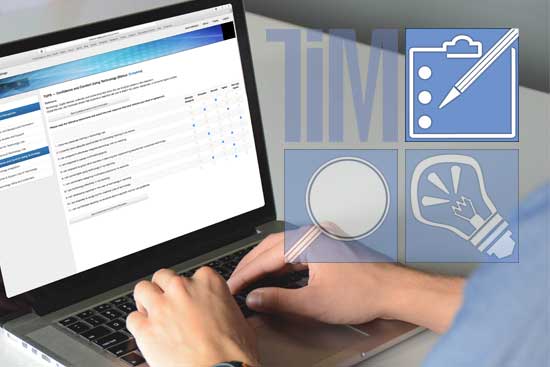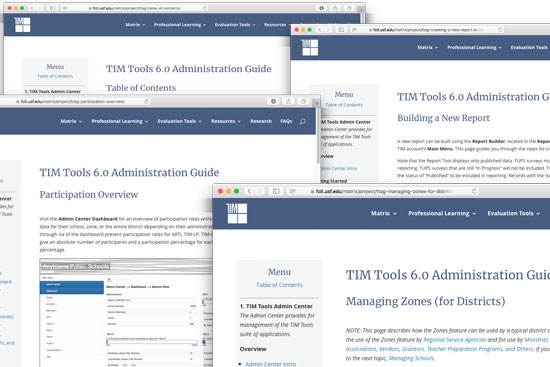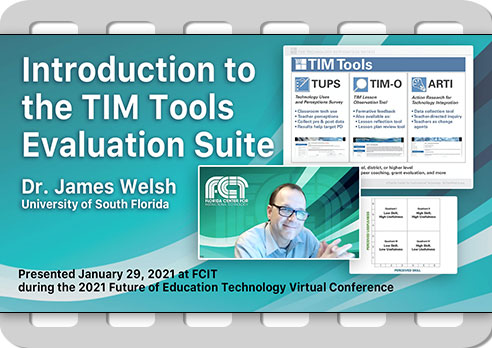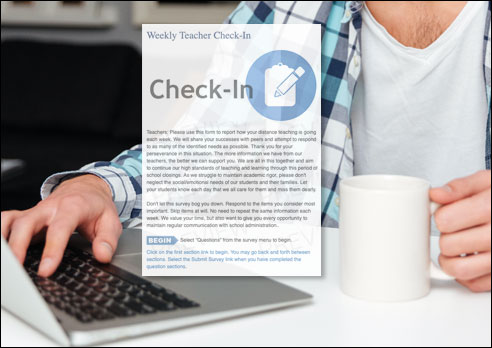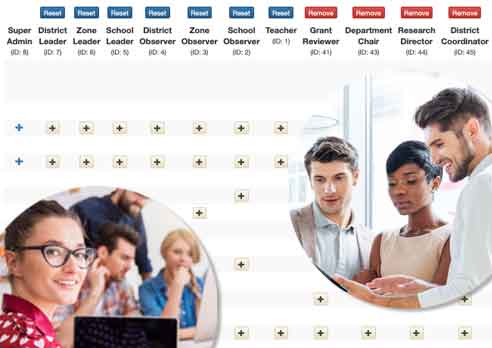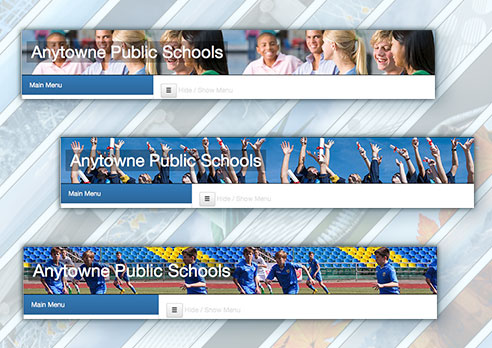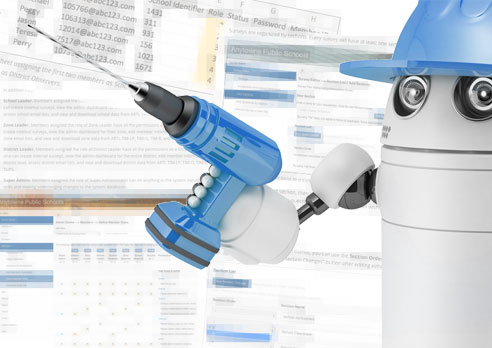TIM Evaluation Tools
Know where you are. Plan where you’re going.
TIM Tools is a suite of technology integration evaluation tools including a variety of different data collection instruments, both quantitative and qualitative, designed to inform decision-making and alignment of resources at the classroom, school, and district levels. These tools include the Technology Uses and Perceptions Survey (TUPS), the Technology Integration Matrix Lesson Observation Tool (TIM-O), the Action Research for Technology Integration (ARTI), the TIM Coaching Tool (TIM-C), and a survey maker. The TIM-O is also available for use as a reflection tool (TIM-R) and a lesson planning tool (TIM-LP). The tools are all managed from a central Administration Center.
TUPS: Technology Uses and Perceptions Survey
Gather data to support decision-making.
This online survey provides essential information about current teacher use and perceptions of technology. The results can be used to collect baseline data for special initiatives, inform technology purchase decisions, identify professional development needs, and facilitate coaching in the use of instructional technology. The TUPS looks at what teachers believe about the role of technology in the classroom, as well as their comfort and confidence with technology in general, with pedagogy of technology, and with a variety of different specific technologies. It also asks teachers about the frequency with which they and their students use those technologies.
TIM-O: Lesson Observation Tool
Document the pedagogical dimensions of classroom technology use.
The TIM-O is a flexible tool for lesson observations that can be used for formative feedback, peer coaching, grant evaluation, or professional development planning. The TIM-O is a web-based system that works on any device and requires no software installation. It’s designed to guide principals, teachers, and others through the process of evaluating the level of technology integration within a particular lesson. When completed, the tool produces a profile for the observed lesson in terms of the Technology Integration Matrix. The TIM-O may be used with online, blended, or face-to-face instruction.
TIM-C: Coaching Tool
Document coaching/mentoring in your school or district.
The TIM-C provides a means to record the goals, activities, progress, and outcomes of a coaching cycle for any subject area. It provides a framework can be used with most coaching or mentoring programs. Since it is an online tool, it can be used to support teachers doing either face-to-face or remote instruction. This tool allows any member to enter into a coaching relationship with any other member for a defined coaching cycle. One member is designated as the coach and the other member is designated as the client. Administrators can add standards or other alignments from any subject area to the Tool.
ARTI: Action Research for Technology Integration
Push the frontiers of great teaching with technology.
As teachers increase integration of technology in their classrooms, they begin to take more responsibility for ensuring its effective use with students. The ARTI tool provides a framework for teachers to design and conduct their own action research projects. ARTI guides teachers through the five basic steps of an action research project: identification of a question, description of the context, data collection, analysis, and the creation of findings.
Survey Tool
Collect data an new topics as needed.
The Survey Tool allows schools and districts to quickly create custom surveys to push out to their staff or to the wider community. Multiple question types allow for the creation of many types of surveys, questionnaires, forms, and reports. Included with the Survey Tool is a starter library of survey topics including: school climate, bullying, home technology use, volunteering, end-of-year checklist, and workshop evaluation. Since the current TIM Tools version allows for the use of a custom school or district header banner, clients can now create public surveys that maintain their school or district branding. The survey tool is especially useful for collecting on-going feedback from parents.
TIM Tools Admin Center
Manage all TIM Tools from a single interface.
The Admin Center is user-friendly, and doesn’t require time for reading complex manuals. The processes for uploading schools and members, assigning administrators and observers, viewing summary usage reports and other common tasks are all explained within the Center. Most importantly, the Admin Center is where you will access your TIM Tools data. Pasting the raw data into specially-designed templates instantly generates extensive reports that identify needs, provide insight into the current levels of technology integration, and pinpoint the most pressing (and promising) professional development topics.
TIM Tools Admin Guide
Everything you need to get the most from your TIM Tools instance.
Administering a TIM Tools instance is not difficult. There are thorough instructions embedded throughout each tool and in the Admin Center. Nonetheless, everything is also covered in an extensive Admin Guide. Here you’ll find how to get started and customize your instance to work best for your particular school or district. There are instructions for creating and defining roles to match your organization’s structure, adding members, and working with data. There’s also a complete section devoted to each of the tools: TUPS, TIM-O, TIM-LP, TIM-R, TIM-C, ARTI, the Report Tool, and the Survey Tool.
The TIM Tools suite is available in both a district and school version. Pricing is by the number of teachers enrolled into the system. Potential clients can view the TIM Tools pricing list and terms. Use our online form to generate an instant quote. Please direct any questions about how TIM Tools can benefit your school or district to TIM@fcit.us
Each month FCIT publishes a newsletter with short articles on teaching and learning with technology, using digital content in the classroom, and professional development for technology integration. Recent posts include Using the TIM-C Coaching Tool, TIM-Powered Research and Evaluation, Active Learning: Engaging Students’ Minds, Leveraging TIM Tools Roles for Research and Evaluation, and Nail Your Next Tech PD with the Quadrant Graph. Subscribe today! The subscription form will open in a new window. When you have subscribed, you can close the new window to return to this page.
You can also submit stories about how TIM Tools have been used in your classroom, school, or district.
Want To Know More?
Schedule a personal walk-through of the TIM Tools for yourself or your staff. See how this flexible set of technology integration tools will meet your school or district's specific needs.
Get an Instant TIM Tools Quote!
Use our no-obligation quote generator to create an instant TIM Tools license quote you can submit to your school or district's purchasing department.
For More Information….
Review these recent TIM Tools posts from our Teaching and Learning with Technology blog.
Video: Introduction to TIM Tools
Dr. James Welsh gives a brief overview of the tools within the TIM Tools suite and walks through some of the functionality and reporting available to TIM Tools users. [17 minutes]
Leveraging Your TIM Tools
Many schools and districts are scrambling to support teachers who suddenly find themselves teaching online for the very first time. In addition, of course, to the technical challenges, schools and districts have an enormous professional development and support…
Using the TUPS to Target Professional Development
Results from the TUPS can be used in planning and targeting technology-related professional development (PD) for teachers. As a self-report survey, the TUPS yields data from a teacher’s perspective that can inform us about what is happening with technology in the classroom as well as factors that may be influencing….
Using the TIM-C Coaching Tool
It comes as no surprise that TIM Tools clients tend to have strong coaching/mentoring programs in their schools or districts. Current clients use the TUPS, TIM-O, and ARTI to support tech planning, resource allocation, research and evaluation, and professional…
Quick and Easy Check-Ins with the Survey Tool
In our recent conversations with teachers and educational leaders at various levels, two things came through loud and clear: everyone is working at maximum capacity to maintain instructional continuity, and the last thing teachers need is another philosophical tome…
TIM-Powered Research and Evaluation
In a previous post I highlighted updates to our published research page and mentioned several ways we are seeing the Technology Integration Matrix (TIM) used in research studies. In this post I would like to give a little more information about each of these…
Nail Your Next Tech PD with the Quadrant Graph
“Teachers are the toughest students.” Everyone who has ever conducted professional development has muttered some variation of that quote at one time or another. It’s no surprise that a classroom of teachers is a tough audience. They spend their days…
3 Things To Look for in Any Classroom Observation Protocol
There are many protocols for observing classroom technology integration, including FCIT’s own Technology Integration Matrix and our corresponding TIM-O tool. In this post, I’m using the word “protocol” broadly to refer to any checklist, survey,…
Do I need a school or a district license?
You might think that a school would always need a School license and a district would always need a District license. While that may be true in most cases, experience has taught us that our clients often use TIM Tools in ways that we never anticipated, so it’s…

TIM Tools Application Programming Interface
With our selection of APIs in the latest TIM Tools release, we’ve created a new way of accessing your data. You can now pull TIM-LP, TIM-O, TIM-R, TUPS, TIM-C, and Survey Tool data directly into your own reporting systems
How many observations do I need?
Here’s a great question I recently received: In your experience, what are the optimal numbers of TIM Lesson Plan (TIM-LP) reviews per teacher and TIM Observations (TIM-O) per teacher to get actionable data? This is an interesting question and there is no…
How often should we administer the TUPS?
We are sometimes asked how often the Technology Uses and Perceptions Survey (TUPS) should be administered. The answer, of course depends entirely upon your purposes, the implementation timeline, and the professional development opportunities available to your…
TIM Tools in Higher Ed
Colleges of education can manage any combination of research projects, grant evaluations, and intern observations in a single “district” version of the software. The…
Regional Agencies, Associations, Consultants, and Others Who Manage TIM Tools on Behalf of Others
Version 6.0 of TIM Tools now makes it much easier for regional service agencies, consultants, foundations, and others to manage multiple clients within a single TIM Tools instance. It’s always been possible to do so and has been done most frequently by…
Three ARTI Scenarios
Most districts begin their use of TIM Tools with the TUPS to capture a snapshot of their technology and professional development needs. They then begin implementing the TIM-O with their teachers. And then, well, they often don’t get to the equally useful action…
Rockin’ Roles in TIM Tools
Each new instance of TIM Tools includes eight predefined roles: Super Administrator, District Leader, Zone Leader, School Leader, District Observer, Zone Observer, School Observer, and Teacher. The default permissions for each of the eight roles are preset to what is…
Custom Banners for Your TIM Tools Instance
While most TIM Tools clients use one of the 100 or so built-in page header images for their site, some clients prefer to make a custom banner to match their other websites or sometimes just their school colors. With just a few minutes effort you can create a custom…
Admin Guide at Your Service
We love interacting with TIM Tools clients via email, phone, or videoconference. Sometimes a conversation with a real live human is the most efficient way of getting started with TIM Tools. When we get a phone call from a tech director who says, “I need to…

